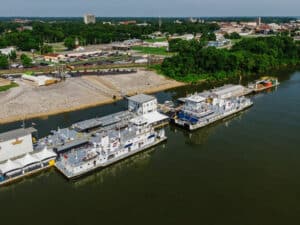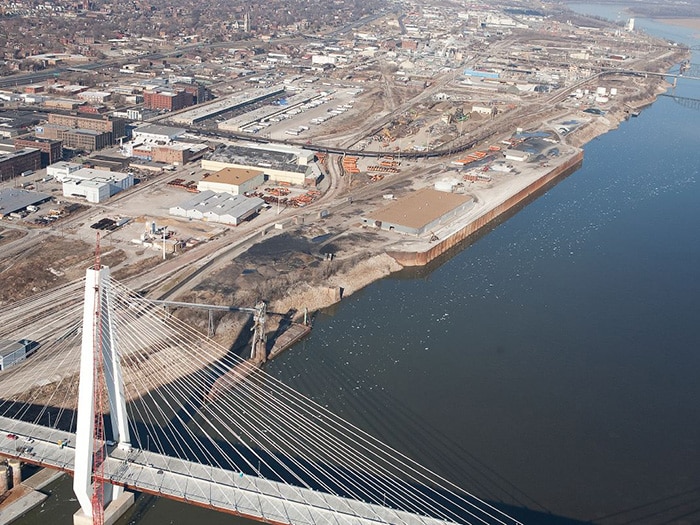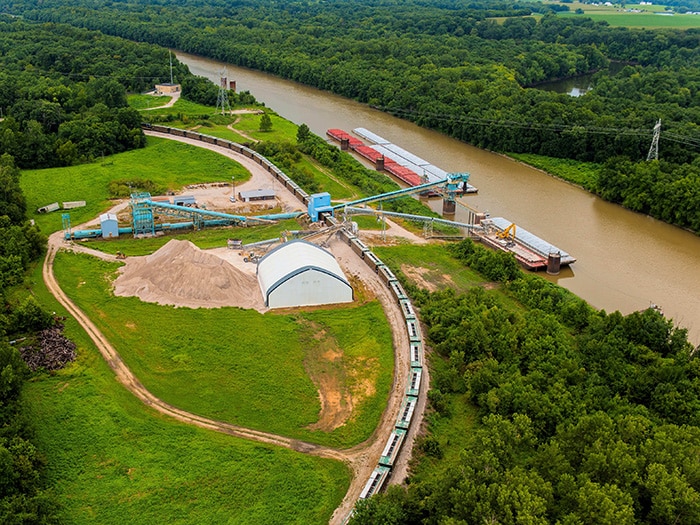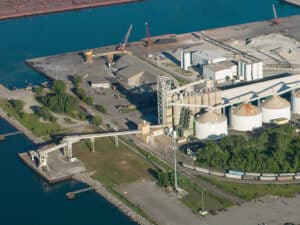
Four St. Louis regional ports invest for the future
Written by Marine Log Staff
Dock by the Stan Musial Veterans/ Memorial Bridge in downtown St. Louis
Investments underway or planned at four ports in the St. Louis, Mo., area are supported by an influx of federal and state funding that underscores the growing importance of inland ports in the global supply chain. The investments have the bi-state region poised to support continued growth in traditional barge services and intermodal operations, while helping to prepare for the arrival of a new container-on-vessel service in the Midwest.
These developments were the focus of a May 23 virtual panel session held as part of the St.Louis Regional Freightway’s FreightWeekSTL 2023 that featured participants from America’s Central Port, St. Louis Development Corporation, Kaskaskia Regional Port District and Jefferson County Port Authority.
America’s Central Port anchors a 1,200-acre multi modal business and industrial site in Granite City, Ill., where a series of infrastructure investments are underway. Built in the 1940s as a military base, the site has been converted into one of the largest freight hubs in the Midwest, with access to six Class-I railroads and two multi modal harbors that bring in more than 3 million tons of product by barge each year. The site is home to more than 75 manufacturers and freight intensive operators that collectively employ an estimated 1,000 workers, and offers 2.1 million square feet of warehouse space, 70,000 square feet of office space and 150 apartments.
According to the port’s executive director, Dennis Wilmsmeyer, the original roads leading into the property were not built to handle the weight of trucks today. To remedy that, a number of developments are under way or planned and come of the heels of a recently completed upgrade of the Bissell Street Rail Crossing.
America’s Central Port will also soon start on a $3 million rehabilitation of a 1940s era, 50,000 square-foot building that was originally used as a locomotive repair shop is now being upgraded for manufacturing purposes. As part of a $15.8 million U.S. Department of Transportation BUILD grant secured for America’s Central Port back in 2020, other upgrades coming to the port include 2,050 linear feet of new railroad track, a new product receiving belt system from barge to rail, barge loading system replacement, rail car load-out upgrades, multi modal transfer equipment modernization and safety upgrades. Grants were also recently secured for a truck calling and staging center, and expansion of the cargo dock at the Granite City Harbor.
The City of St. Louis Port Authority, located in downtown St. Louis, comprises about 10,000 acres along 19-plus miles of riverfront on the Mississippi River and moves 15 to 18 million tons of cargo a year. A landlord port, it has approximately 40 leases with shippers and carriers and fleeting operators up and down the river, and its main terminal is the Municipal River Terminal (MRT), located about a mile and a half north of the Gateway Arch and operated by SCF Lewis and Clark Terminals. The 40-acre site has a 2,000-foot dock that can hold 250-ton crane loads and features 67 fleeting berths, 250,000 square feet of warehouse space, and direct rail service.
The port authority has invested about $10 million in the Municipal River Terminal over the past couple of years. Recent additions include a rail river conveyor system and direct rail access into the yard, and portions of the yard are currently being paved. SCF recently secured a grant for unitized cargo equipment to get unit train capability at the terminal. As part of a $9 million BUILD grant secured through SCF, 7,350 linear feet of new railroad track will be added, and that is expected to drive more rail traffic to the facility.
“We’re trying to develop a new rail and river terminal on our south riverfront and have secured a $5.76 million ARPA grant towards that,” said Susan Taylor, port authority director for the St. Louis Development Corporation, “We’re talking to a new lessee about a potential liquid fertilizer dock on our north riverfront, and we plan on issuing some RFPs soon for fleeting. There’s also a developer interested in a large $1.2 billion project, just south of the MacArthur Bridge, and it will focus on manufacturing and, hopefully, container on vessels shipping of the manufactured goods.”
As a political subdivision of the state, the port authority also can offer major investment incentives. In 2018, it issued $15 million in bonds to an agricultural entity on the south riverfront to help propel its $37 million expansion. In 2019, $8.75 million in bonds was issued to a scrap company to buy and relocate a shredder on the north riverfront, enabling the company to consolidate operations and to expand. Taylor also highlighted the port authority’s ability to create port improvement districts, saying that it is in the process of creating one for the new soccer stadium in downtown St. Louis, which encountered some unexpected groundwater pollution. The port improvement district will help generate funds to address that issue.
Located just 30 miles south of St. Louis, the Kaskaskia Regional Port District encompasses Monroe, Randolph and St. Clair counties in Illinois and, by tonnage, is the 15th largest inland port in the U.S. The port district has four port locations on the Kaskaskia River and one on the Mississippi River. Kaskaskia Regional Port District General Manager Ed Weilbacher talked about the investments being made his terminals, starting with Kaskaskia Regional Port District Terminal 1, operated by Kaskaskia River Terminals and located just outside of New Athens, Ill. The site was originally an outbound coal facility that was repurposed into an inbound offloading facility that ships scrubber stone about 15 years ago. Recently, the site has been producing waste products like gypsum and fly ash that have marketability, and the terminal will undergo $20 million in upgrades to ship 2 million tons of product outbound while simultaneously maintaining the inbound cargo movement. The upgrades include a second rail loop, a new rail yard at the terminal, and updates to the rail corridor that runs from the terminal to Lenzburg, Ill.

Investments are also being made at Kaskaskia Regional Port District Terminal 2, a multi modal river, rail and road facility for steel, general cargo and bulk products located in Baldwin, Ill., along the Kaskaskia River. Approximately $2.7 million in grants were secured from IDOT for a new conveyor to move fertilizer from the dock to an expansion that is taking place at tenant Gateway FS, with the goal of increasing fertilizer throughput at that location. The facility also received a recent freight grant to double track the rail underneath the overhead crane, which will reduce congestion and improve safety at that location, priming the facility for future growth. Grant applications for $14 million were recently submitted for a new south dock at Kaskaskia Regional Port District Terminal 2, and the Port also applied for a $1.3 million U.S. Marine Highway grant for a series of shuttle cars that will allow for the movement of coiled steel through the terminal to keep pace with the increase in coiled steel at this location. The Kaskaskia Regional Port District is also seeking $3 million in grant funding for the addition of a second entrance road to the terminal and a laydown yard for one of its tenants.
“Kaskaskia Regional Port District is poised for significant growth,” Weilbacher said. “With these upgrades, we’re going to have great capacity within our terminals to move cargo to any tenant that wants to locate there.”
Weilbacher also talked about a feasibility study underway with the Army Corps of Engineers to construct a pipeline from the northernmost terminal on the Kaskaskia River to Scott Air Force Base. A pipeline would more safely transfer fuel to the base, versus continuing to have it trucked in.
“If we want to keep Scott Air Force Base thriving and off any future closure list, we need to look at an alternative fuel source for that base,” Weilbacher said.
Jim McNichols, executive director of the Jefferson County Port Authority talked about expansion plans for the port authority, which is located south of St. Louis County, with boundaries encompassing the entirety of Jefferson County, Mo. The Jefferson County Port Authority has a dock in Kimmswick, Mo., but does not currently operate any facilities. That will change with the addition of a new port facility planned for Herculaneum that will bring American Patriot Holding’s (APH) new innovative container-on-vessel (COV) service to the Midwest. The container facility will be a key hub on a the planned all-water, north-south trade lane connecting the St. Louis region to the lower Mississippi River and on to worldwide destinations.
“We were able to take the momentum received from American Patriot’s announcement and head to Jefferson City last year to secure an appropriation of $25 million that will fund a list of approximately 14 infrastructure-related projects that need to be completed for the site to be prepared to receive APH’s liner vessels,” McNichols said. “Some of the projects that are well advanced include the design and construction of new access roads, relocation of existing utilities, and the permitting design and construction of a new bulk materials processing facility that will be located on the southeastern portion of the property.”
Leveraging the $25 million in state funds received from Missouri, the Jefferson County Port Authority has taken advantage of an additional opportunity made possible by the creation of a series of grant programs fueled by federal ARPA funding that the Missouri Department of Economic Development designed to help some of the most impacted industries recover from the pandemic-related shutdowns and revenue losses. One program was specifically designed to identify previously utilized industrial sites that have fallen out of productive use and to provide seed funding to bring them back online. After identifying 2,200 acres on six miles of Mississippi River frontage, the Jefferson County Port Authority applied for the mega-site designation of 1,000 contiguous acres or more, which means the $25 million in state appropriations could be matched dollar for dollar.
“The critical portion of all of these sites is they all contain multiple modes of ingress and egress into them and out of them,” said McNichols. “Now you combine this opportunity with the currently approved and budgeted expansion of I-55, and the momentum generated by these projects really dovetails with our overall effort.”
- You can see a video of the St. Louis regional ports panel session HERE


![Tom Frazier aground and listing to starboard on Feb. 11, 2024. [Photo: U.S. Coast Guard]](https://www.marinelog.com/wp-content/uploads/2025/06/Towboataground-300x225.jpg)

